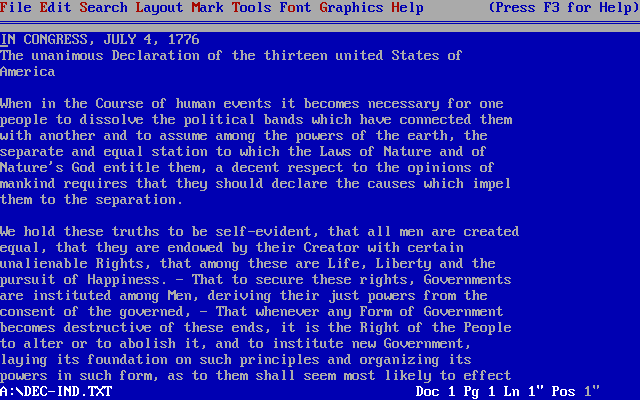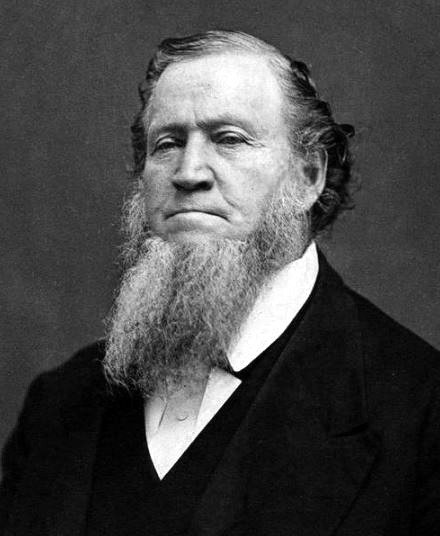|
Corel WordPerfect Office
WordPerfect (WP) is a word processing application, now owned by Alludo, with a long history on multiple personal computer platforms. At the height of its popularity in the 1980s and early 1990s, it was the market leader of word processors, displacing the prior market leader WordStar. It was originally developed under contract at Brigham Young University for use on a Data General minicomputer in the late 1970s. The authors retained the rights to the program, forming the Utah-based Satellite Software International (SSI) in 1979 to sell it; the program first came to market under the name SSI*WP in March 1980. It then moved to the MS-DOS operating system in 1982, by which time the name WordPerfect was in use, and several greatly updated versions quickly followed. The application's feature list was considerably more advanced than its main competition WordStar. Satellite Software International changed its name to WordPerfect Corporation in 1985. WordPerfect gained praise for its "loo ... [...More Info...] [...Related Items...] OR: [Wikipedia] [Google] [Baidu] |
Brigham Young University
Brigham Young University (BYU) is a Private education, private research university in Provo, Utah, United States. It was founded in 1875 by religious leader Brigham Young and is the flagship university of the Church Educational System sponsored by the Church of Jesus Christ of Latter-day Saints (LDS Church). BYU offers a variety of academic programs including those in the liberal arts, engineering, agriculture, management, physical and mathematical sciences, nursing, and law. Its undergraduate and graduate programs are organized into 11 colleges and schools at its main Provo campus, with some colleges and divisions defining their own admission standards. The university also administers four satellite campuses, one in BYU Jerusalem Center, Jerusalem, BYU Salt Lake Center, Salt Lake City, BYU Barlow Center, Washington, D.C., and BYU London Study Abroad Centre, London, while its parent organization the Church Educational System (CES) sponsors sister schools in Brigham Young Unive ... [...More Info...] [...Related Items...] OR: [Wikipedia] [Google] [Baidu] |
Microsoft Word
Microsoft Word is a word processor program, word processing program developed by Microsoft. It was first released on October 25, 1983, under the name Multi-Tool Word for Xenix systems. Subsequent versions were later written for several other platforms including IBM PCs running DOS (1983), Apple Macintosh running the Classic Mac OS (1985), AT&T UNIX PC (1985), Atari ST (1988), OS/2 (1989), Microsoft Windows (1989), SCO Unix (1990), Handheld PC (1996), Pocket PC (2000), macOS (2001), Web browsers (2010), iOS (2014), and Android (operating system), Android (2015). Microsoft Word has been the ''de facto'' standard word processing software since the 1990s when it eclipsed WordPerfect. Commercial versions of Word are licensed as a standalone product or as a component of Microsoft Office, which can be purchased with a perpetual license, as part of the Microsoft 365 suite as a Software as a service, subscription, or as a one-time purchase with Office 2024. History In 1981, Microsoft ... [...More Info...] [...Related Items...] OR: [Wikipedia] [Google] [Baidu] |
Subdirectories
In computing, a directory is a file system cataloging structure that contains references to other computer files, and possibly other directories. On many computers, directories are known as folders or drawers, analogous to a workbench or the traditional office filing cabinet. The name derives from books like a telephone directory that lists the phone numbers of all the people living in a certain area. Files are organized by storing related files in the same directory. In a hierarchical file system (that is, one in which files and directories are organized in a manner that resembles a tree), a directory contained inside another directory is called a subdirectory. The terms parent and child are often used to describe the relationship between a subdirectory and the directory in which it is cataloged, the latter being the parent. The top-most directory in such a filesystem, which does not have a parent of its own, is called the root directory. The freedesktop.org media type for d ... [...More Info...] [...Related Items...] OR: [Wikipedia] [Google] [Baidu] |
CP/M
CP/M, originally standing for Control Program/Monitor and later Control Program for Microcomputers, is a mass-market operating system created in 1974 for Intel 8080/Intel 8085, 85-based microcomputers by Gary Kildall of Digital Research, Digital Research, Inc. CP/M is a disk operating system and its purpose is to organize files on a magnetic storage medium, and to load and run programs stored on a disk. Initially confined to single-tasking on 8-bit processors and no more than 64 kilobytes of memory, later versions of CP/M added multi-user variations and were migrated to 16-bit processors. CP/M's core components are the ''Basic Input/Output System'' (BIOS), the ''Basic Disk Operating System'' (BDOS), and the ''Console Command Processor'' (CCP). The BIOS consists of drivers that deal with devices and system hardware. The BDOS implements the file system and provides system services to applications. The CCP is the command-line interpreter and provides some built-in commands. CP ... [...More Info...] [...Related Items...] OR: [Wikipedia] [Google] [Baidu] |
X86 Assembly Language
x86 assembly language is a family of Low-level programming language, low-level programming languages that are used to produce object code for the x86 class of processors. These languages provide backward compatibility with CPUs dating back to the Intel 8008 microprocessor, introduced in April 1972. As assembly languages, they are closely tied to the architecture's machine code instructions, allowing for precise control over hardware. In x86 assembly languages, mnemonics are used to represent fundamental CPU instructions, making the code more human-readable compared to raw machine code. Each mnemonics corresponds to a basic operation performed by the processor, such as arithmetic calculations, data movement, or Control flow, control flow decisions. Assembly languages are most commonly used in applications where performance and efficiency are critical. This includes Real-time operating system, real-time embedded systems, operating system, operating-system Kernel (operating system) ... [...More Info...] [...Related Items...] OR: [Wikipedia] [Google] [Baidu] |
Compiler
In computing, a compiler is a computer program that Translator (computing), translates computer code written in one programming language (the ''source'' language) into another language (the ''target'' language). The name "compiler" is primarily used for programs that translate source code from a high-level programming language to a lower level language, low-level programming language (e.g. assembly language, object code, or machine code) to create an executable program.Compilers: Principles, Techniques, and Tools by Alfred V. Aho, Ravi Sethi, Jeffrey D. Ullman - Second Edition, 2007 There are many different types of compilers which produce output in different useful forms. A ''cross-compiler'' produces code for a different Central processing unit, CPU or operating system than the one on which the cross-compiler itself runs. A ''bootstrap compiler'' is often a temporary compiler, used for compiling a more permanent or better optimised compiler for a language. Related software ... [...More Info...] [...Related Items...] OR: [Wikipedia] [Google] [Baidu] |
C (programming Language)
C (''pronounced'' '' – like the letter c'') is a general-purpose programming language. It was created in the 1970s by Dennis Ritchie and remains very widely used and influential. By design, C's features cleanly reflect the capabilities of the targeted Central processing unit, CPUs. It has found lasting use in operating systems code (especially in Kernel (operating system), kernels), device drivers, and protocol stacks, but its use in application software has been decreasing. C is commonly used on computer architectures that range from the largest supercomputers to the smallest microcontrollers and embedded systems. A successor to the programming language B (programming language), B, C was originally developed at Bell Labs by Ritchie between 1972 and 1973 to construct utilities running on Unix. It was applied to re-implementing the kernel of the Unix operating system. During the 1980s, C gradually gained popularity. It has become one of the most widely used programming langu ... [...More Info...] [...Related Items...] OR: [Wikipedia] [Google] [Baidu] |
Computerworld
''Computerworld'' (abbreviated as CW) is a computer magazine published since 1967 aimed at information technology (IT) and Business computing, business technology professionals. Original a print magazine, ''Computerworld'' published its final print issue in 2014; since then, it has been available as an online news website and as an online magazine. As a printed weekly during the 1970s and into the 1980s, ''Computerworld'' was the leading trade publication in the data processing industry. Based on circulation and revenue it was one of the most successful trade publications in any industry. Later in the 1980s it began to lose its dominant position. It is published in many countries around the world under the same or similar names. Each country's version of ''Computerworld'' includes original content and is managed independently. The publisher of ''Computerworld'', Foundry (formerly IDG Communications), is a subsidiary of International Data Group. History The publication was lau ... [...More Info...] [...Related Items...] OR: [Wikipedia] [Google] [Baidu] |
IBM PC
The IBM Personal Computer (model 5150, commonly known as the IBM PC) is the first microcomputer released in the List of IBM Personal Computer models, IBM PC model line and the basis for the IBM PC compatible ''de facto'' standard. Released on August 12, 1981, it was created by a team of engineers and designers at IBM, International Business Machines (IBM), directed by William C. Lowe and Philip Don Estridge in Boca Raton, Florida. Powered by an x86-architecture Intel 8088 processor, the machine was based on open architecture and third-party peripherals. Over time, expansion cards and software technology increased to support it. The PC had influence of the IBM PC on the personal computer market, a substantial influence on the personal computer market; the specifications of the IBM PC became one of the most popular computer design standards in the world. The only significant competition it faced from a non-compatible platform throughout the 1980s was from Apple Inc., Apple's Maci ... [...More Info...] [...Related Items...] OR: [Wikipedia] [Google] [Baidu] |
Wang Laboratories
Wang Laboratories, Inc., was an American computer company founded in 1951 by An Wang and G. Y. Chu. The company was successively headquartered in Cambridge, Massachusetts (1954–1963), Tewksbury, Massachusetts (1963–1976), Lowell, Massachusetts (1976–1995), and finally Billerica, Massachusetts. At its peak in the 1980s, Wang Laboratories had annual revenues of US$3 billion and employed over 33,000 people. It was one of the leading companies during the time of the Massachusetts Miracle. The company was directed by An Wang, who was described as an "indispensable leader" and played a personal role in setting business and product strategy until his death in 1990. The company went through transitions between different product lines, beginning with typesetters, calculators, and word processors, then adding computers, copiers, and laser printers. Wang Laboratories filed for bankruptcy protection in August 1992. After emerging from bankruptcy, the company changed its name to Wa ... [...More Info...] [...Related Items...] OR: [Wikipedia] [Google] [Baidu] |
Filename Extension
A filename extension, file name extension or file extension is a suffix to the name of a computer file (for example, .txt, .mp3, .exe) that indicates a characteristic of the file contents or its intended use. A filename extension is typically delimited from the rest of the filename with a full stop (period), but in some systems it is separated with spaces. Some file systems, such as the FAT file system used in DOS, implement filename extensions as a feature of the file system itself and may limit the length and format of the extension, while others, such as Unix file systems, the VFAT file system, and NTFS, treat filename extensions as part of the filename without special distinction. Operating system and file system support The Multics file system stores the file name as a single string, not split into base name and extension components, allowing the "." to be just another character allowed in file names. It allows for variable-length filenames, permitting more than o ... [...More Info...] [...Related Items...] OR: [Wikipedia] [Google] [Baidu] |





